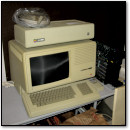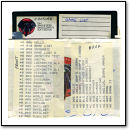[ Retro Scan of the Week ] Precursor to the Digital Camera
November 26th, 2007 by Benj Edwards
How did they work? Think of a CCD video camera without motion. Still video cameras captured single frames of electronic video and stored them on removable magnetic discs in an analog video format. In order to get the images onto a computer (assuming that’s what you wanted to do), each video still had to be digitized with a computer video capture device (much like today’s TV tuner cards). But it wasn’t long until fully digital consumer cameras made this cumbersome process — and analog electronic cameras — obsolete.
[ From MacUser – December, 1989 ]
If you use this image on your site, please support “Retro Scan of the Week” by giving us obvious credit for the original scan and entry. Thanks.






November 26th, 2007 at 5:42 pm
Commodore/MOS engineers were apparently experimenting with videophones and digital picture transmission back in the late 1970s…
November 27th, 2007 at 1:42 am
wow… i never knew they had a ‘digital’ camera back in 81… thats pretty sweet